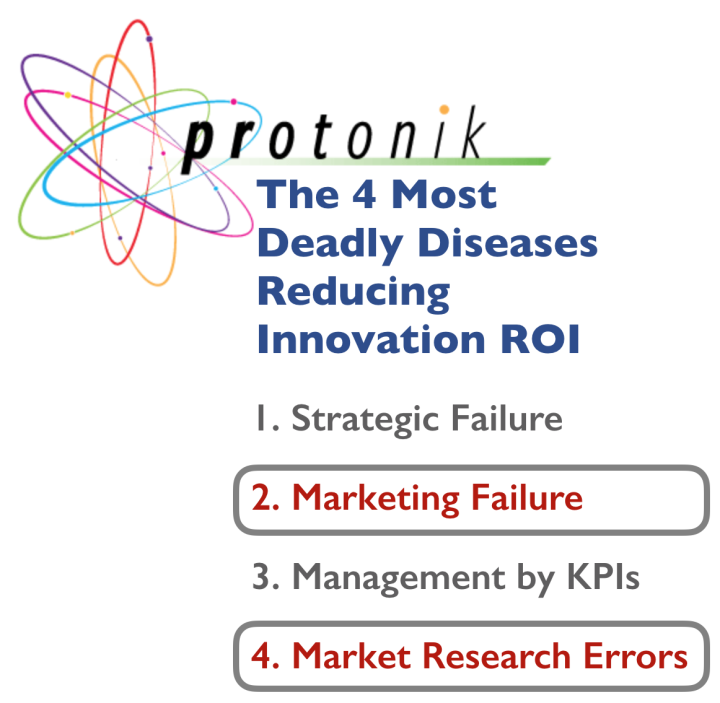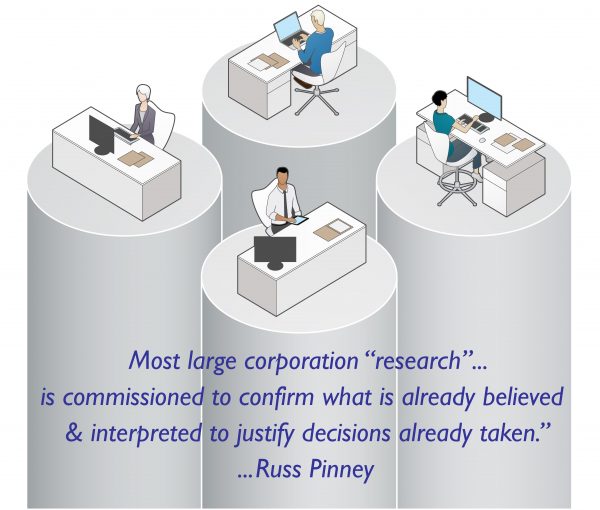
Marketing Failure & Market Research Error: Two Unspoken Reasons Innovation Fails. (Four Deadly Diseases, Part 1)

“As any doctor can tell you, the most crucial step toward healing is having the right diagnosis. If the disease is precisely identified, a good resolution is far more likely.” Andrew Weil
Recent research claims to identify the “top obstacles to innovation” in large companies. (A summary by Scott Kirsner can be found in the Harvard Business Review.***)
I recommend reading the article. But take care — this research only tells us about the symptoms of innovation problems not the fundamental diseases underlying the symptoms. So we need to dig deeper and diagnose the underlying diseases driving these symptoms.
This is the first in a series of posts discussing the 11 diseases I’ve identified which drive innovation problems — diseases which affect all companies and not just the large ones. These come from considering 35 years (so far) creating and marketing innovative new products and services across a range of industries (from tech and aerospace to consumer goods and advertising) and a range of corporations including Dupont, Rubbermaid, DirecTV, General Dynamics and Lowe’s.
Four of the 11 diseases are most critical – let me call them the Four Deadly Diseases including Strategic Failure, Marketing Failure, Management by KPI, and Market Research Errors. I’ll get to the 7 Secondary Diseases in later posts.
Let’s begin our discussion not with the #1 disease, but with the two diseases related to marketing.
Deadly Disease #2: Marketing Failure
Marketing failure is almost never talked about. Why? After all, my experience is that failure of marketing is where the largest number of innovations fail. And they’d don’t just fail because of poor communications. They fail for fundamental flaws throughout the 4Ps (which summarize marketing’s range of action).
The issue starts, I believe, in that innovation seems to be considered primarily the domain of engineering, R&D, & product design. Lacking core understanding of products and customers, these groups often believe that great innovation will sell itself — as long as they do their jobs perfectly. Hence we are pummeled with more and more books about perfecting the innovation process. And marketing remains ignored – in both the books and in companies. In the end, too many companies never tap the incredible strength marketing should bring new product development and innovation projects.
It continues, from what I observe, with a kind of prejudice against marketing. I think the issue lies in the difference between the complex and non-linear challenges in marketing vs the more often linear and complicated challenges in other organizations.
Marketing’s job is to connect the human (customers, buyers, consumers, product users) to the hard core delivery of the company (products, services). No other organization in the modern company is so heavily driven by the vagaries of the human as marketing – not even HR.
Yet seeking to be “masters of the universe” pulling levers to drive big change, business management attempts use detailed KPI based management systems to dodge the uncertainty of human challenges (see disease #3). Up against the hard issues of engineering, manufacturing, HR and finance, what the company needs from marketing in order to succeed can frustrate other execs — thus making the CMO the odd man out in the boardroom.
Marketing is also too often reduced to merely “advertising” or “PR”. But marketing is a discipline that covers a wide range – especially all the customer oriented marketer skills in all of marketing’s 4Ps (Product, Price, Place, and Promotions). While 90% of marketing budget might be spent buying media, 90% of marketing effort needs to go into everything BUT advertising and PR.
Lastly, marketing is expensive. As a result, companies generally don’t plan marketing budgets as part of innovation. The result is that innovation projects don’t get the guidance needed to create excellent customer value that is sell-able nor does the product get the support it needs when it goes to market.
Yet marketers are the employees best trained in the human realities around innovation, customers, and guiding innovation to create the conditions for demand. Innovation thrives best when customer oriented marketers are deeply involved BEFORE any attempts to quantify market size or resolve key design/R&D/engineering decisions. And there are tremendous benefits that come to the innovation team:
- Only marketers have the experience to understand the true value a product delivers to customers and how trade offs in product design affect that value. (I see a lot of writing by engineers who struggle and fail to effectively understand customer value.)
- Only marketers are thoroughly skilled in the process by which your products are distributed and bought. So only marketers can anticipate how design, engineering, or R&D changes affect that process.
- Only marketers understand how to identify important product details which will increase sales and help sort those out from features which may not. Note that not all features critical for sales are the ones critical for long term satisfaction from owning the product. This is a very, very important distinction discussed far too rarely.
- Only marketers understand the process by which innovations are adopted.
- Only disciplined, well trained, instinctively aware marketers can guide your product development toward those products and services which drive outstanding sales.
- And marketers are the ones who best understand how to leverage communication to drive innovation success.
Let me note there are cases where someone in one of the key design or engineering organizations has the instincts and skills to work out the market challenges. Let me also be clear that not all marketers are well versed in the skills I listed – only those who have been exceptionally well trained and/or have an exceptional career working in all phases of marketing. However, most companies will do best to default to looking in the marketing department for these skills then being sure to choose carefully which marketers have these skills.
Nowhere in Kirsner’s article or the KPMG research, though, is marketing discussed.
That’s typical. Companies usually opt for “business as usual” marketing with innovation and new products. Yet your exciting new product will always fail to meet expectations when it gets the same marketing you’d use to milk profit from a well established product. Even worse, this has been standard operating procedure for so long that marketing of innovation is not recognized for the specialty it should be.
Most marketers lack significant experience with driving innovation success. Why? Marketing departments only introduce a new, dramatically innovative product every 4 to 8 years. This means, for example, in the past 25 years where I’ve worked with bringing around 200 truly innovative products to market or to a new market, most marketer will have worked with 6 to 8.
Startups often turn to marketers who have been at early phase companies believing they know how to make innovations thrive. Yet my experience with these marketers hasn’t been shown that belief to be well founded. Some dedicated early phase marketers are superb marketers. But too many merely copy their prior work into each situation – resulting in failure or mediocrity because their narrow viewpoint never sees the unique opportunities to deliver big success in the new situation.

Customer focused work is where most errors are made with innovation. There are marketing roles which are very detailed and engineering-like. Unfortunately, it’s with this kind of technical marketing where most product and innovation projects start.
That means innovation projects throw money at “market analysis” before they know which customers will value what they might deliver. It’s silly to throw money at market analysis without knowing who the market is. Unfortunately, there’s a hubris around the engineering parts of marketing which presumes they can choose who the market is – not understanding that customers may or may not agree.
So customer work must start during the earliest investigation of innovations and must continue through to initial market success and even through the first 4-5 years in the market.
Innovation requires higher marketing budgets. Innovative new products require more research than an on-going product requires. They also need higher than normal advertising spending (if advertising – online or offline – is used). In advertising, a planning rule is that to capture 20% of the market with a new product, spend the ad dollars you’d need for a 40% share.
For discussion purposes, it’s probably appropriate to apply this 2:1 rule for all areas around the marketing of innovation.
Unfortunately, companies usually never even get close to the budget they need dedicated to innovative new products or services. Instead, in a classic Catch-22, management demands marketers support innovation and new product work within existing budgets then hold their feet to the fire when lack of funds causes their existing lines or their innovative new products — or both — to fall short.
The need for initial (immediate) sales also makes marketing innovative new products different.
For an on-going line, there is sales momentum and communication that is already known to work. So introducing modified products or new versions can focus almost entirely on long term issues. But for a truly innovative product there is no momentum and no one knows how to communicate it yet. Innovation marketing must create all this.
The need for early sales is absolute — it’s true for every market and for every type of product: sales from the moment the product hits the market determine the kind of success it will have.
 In a retail market, for example, a product gets about 6 weeks on the shelf before a merchant decides it’s fate. That means that any retail oriented advertising you do MUST drive immediate sales in the store. This can only be done with product advertising that has excellent brand qualities. It can’t be done with what’s called “brand advertising”. (Unfortunately, most ad agencies are specialist only with brand advertising and don’t even know there’s a difference.) In fact, failure to use the right advertising for a product introduction has killed tens of thousands of innovative products.
In a retail market, for example, a product gets about 6 weeks on the shelf before a merchant decides it’s fate. That means that any retail oriented advertising you do MUST drive immediate sales in the store. This can only be done with product advertising that has excellent brand qualities. It can’t be done with what’s called “brand advertising”. (Unfortunately, most ad agencies are specialist only with brand advertising and don’t even know there’s a difference.) In fact, failure to use the right advertising for a product introduction has killed tens of thousands of innovative products.
The worst of markets seems to be movies where a new release is rated on first night/weekend sales. Fortunately not every market is as unforgiving as retail or entertainment. Yet every innovative new product must show sales velocity early or the innovation investment is unlikely to ever pay off well.
The Brand Police are a Surprise “Department of NO!”
Within most marketing departments there are people who officially, or unofficially, have responsibility for maintaining “brand consistency”. We are told that strictness here is of utmost importance so the brand police become incredibly bureaucratic — attempting to define, in advance, creative treatment for every possible situation.
The brand police gain extra power when companies add the brand to their balance sheet. There’s a problem, though. While the brand DOES have incredible value, it isn’t a set of creative assets or absolute rules. The brand resides in the hearts and minds of customers — the creative work are distinctive assets that help the company lead people to buy more easily.
The most important thing for brand health is keeping the brand’s place fresh in the hearts and minds of consumers so that they buy your product when it’s the right thing for them to do.
New, innovative products need to enhance brand value in consumer hearts. That also means “expand the brand value”. It would take a very long discussion to look at expand “how far”. Still, I hear tale after tale where the brand police kill innovation because it doesn’t fit in their vision of the brand. Prior to the Tiger Woods deal, Nike almost killed what became their highly profitable golf venture because of arcane brand theories about whether golf was a game or a sport.
Innovations will push at the edge of brand. And there are many judgement calls to be made. But one thing must be clear: The brand police must not be allowed to stop down what’s strategically critical. They too often do.
Marketing of innovation takes unusual marketers. They need:
- The instincts and listening ability to hear clearly what customers say and sort through the noise to find what matters.
- To extract reliable opportunities from listening to customers and matching that against product design/engineering opportunity.
- To be a strong enough salesman/woman to know how to set the market up for excellent initial sales.
- To understand distribution and sell-in as an entrepreneur. (Many in an established sales force lack this sense of selling because they are primarily account managers.)
- To do all this aware of the the subtle marketing choices which set your company up for a long term success. (Without long term success, your innovation ROI is too low.)
Marketing failure is no small problem. I can’t begin to count how many times I’ve heard companies say “competitor X tried that product and failed” when all competitor X did was toss out some technology without marketing support.
As a result, there are vast stores of good innovations already sitting in the back rooms of companies and their competitors — innovations customers never heard about or where the companies didn’t understand their customers well enough to deliver the value needed for sales success. This is an incredible opportunity for companies if they’ll open their minds and innovation thinking.
But what if my innovation isn’t targeted for market release? It’s true that companies need to pursue many innovations which don’t result in new products or even significant changes to products and services.
BUT take care. If your innovation work doesn’t affect your market situation, why are you doing it? Manufacturing changes to improve quality or to lower cost affect your market situation (and too often introduce surprise harmful impact on the market).
No matter what innovation you are pursuing, customer oriented marketing must be involved even if it won’t be released in a new product or service. You should also involve your marketers with internal communication — after all, you’d better hope they’re the ones who do it best.
Deadly Disease #4: Market Research Error
Let’s turn from marketing, now, to market research. Creating market research to guide innovation is quite difficult and tricky – don’t let anyone tell you otherwise. It’s also incredibly important. And there are very few companies who do it well.

As with marketing issues it’s important to recognize that the vast sum of market research (99%+) is conducted to support ongoing products and brands. So whether you have a well defined vendor list or an internal research department, it’s unlikely that you have the right people to do research to guide your innovation projects.
There’s also a big difference between research teams who power incredible innovation and those who support on-going company business like brand management. market analysis, competitive environments, etc.. In part, this is because most market research is designed to deliver closed end answers – answers that reduce and limit risk or accurately predict the future.
Innovation is exactly the opposite. To create great & innovative products you need to take risks. The research job is to learn where there is opportunity and help sort out WHICH risk is worth taking. So attempting to avoid innovation risk with research is a fools errand.
A more serious problem isn’t the actual risk – rather that research discovers things that have unknown risk. Unknown risk is probably a bureaucracy’s (and therefore the research department’s) worst nightmare. Innovation succeeds by articulating risk or suggesting when the size or impact of risk is unknown. Then, a good process begins a slow, not panicked process to control the risk and increase the potential reward.
Research supporting innovation also needs to leave room for serendipity – because all innovation requires serendipity to be succeesss. Like the guy at 3M with the inadequate glue that became the foundation of PostIts. Or the serendipity of discovering an unmet and unspoken need among customers that your company happens to be in a unique position to resolve.
Christensen rightly observes that truly unusual and important innovations aren’t found through normal corporate research. Innovators must use research to search for threads they can follow and, perhaps, weave together with other ideas to create powerful products. Market research supporting innovation must uncover surprising or unusual opportunities to create value for customers which they will also pay for.
In my own innovation work, I find the most value from exploratory research. Working with my good friend and researcher Carla Roberts over the past 25 years we’ve developed an approach to research oriented around learning and exploration – not the usual rubber stamping or verifying. Rather than demand closure, we work to open people up in order to learn the unusual from them. We use stimuli extensively to help their discussion develop more deeply and reveal more tightly held sensibilities. Our goal is to discover the unusual – the opportunities for products that deliver tremendous value.
The result is we come to understand the customer, their situation, their response to certain ideas and possibilities, and understand the value product(s) can bring them. This understanding is also shared across the entire team through the research process.
Sadly, exploratory research makes many companies uncomfortable. Too many enter the research demanding clear, firm, quantifiable answers. Demanding early clarity kills innovation.
Others hate the process of being surprised to discover what they didn’t know before. And exploration makes individuals uncomfortable because it lacks the blessing of statistics. What we forget is that demanding statistical validation quite often kills highly profitable potential innovation (Christensen’s point).
Tony Ulwick’s comments around research and his JTBD seem to reflect all these errors. He theorizes an extensive ranking system with KPI’s that can only result from cautious research. It’s a highly complicated method and seems to fit with his primary role as an engineer. It also lacks sophisticated understanding of people – like those people who might buy the product(s).
It’s my sense that his JTBD is popular because it appeals to an MBA, engineering, and, especially, software development desire for detailed answers to specific questions. That may make the bureaucracy happy but it won’t lead to opportunity for incredible new products. (From the Ulwick JTBD case studies I’ve read, the focus on safety finds only small ball innovation opportunity.)
Research should be used throughout development and release. Choosing different research for innovation needs to continue throughout development and go-to-market execution. For example, given the critical nature of initial sales, I run research projects regularly to learn how best to sell the planned product and do that months before it’s ever ready to reach the market.
Sometimes our sales oriented research work even discovers surprise product assumptions which hurt customer value – and that gives us a chance to improve the product As the actual product comes more and more into focus, we are able to guide both the communication and final product so buyers become will have the features needed to justify to purchase it AND be satisfied with their purchase. (These may or may not be connected.)
Be wary of “innovative marketing” and “innovative research”
I want to add a very specific caution: Marketing innovative products is not best done with innovative media or innovative, untested marketing methods.
You DO need innovative marketing to succeed with introducing new products and services. But that’s generally in the details of how you approach the marketing – not using the latest shiny bauble from AdTech or the newest groovy theory of “purpose”. In fact, online advertising providers have preyed specifically on innovators in building erroneous theories about media.
The same is true in market research. Many research companies claim they are research “innovators”. There was once a case study of this “innovative research” written up in the New York Times. It was BAD research – whether or not it was innovative. In fact, as I note in this blog post the research was a Rorschach — the write up about the research would tell us more about the researcher than about the topic.
Companies Find Far more Powerful New Products with Good Marketing
It is critical that companies embrace the power that marketing adds to their efforts to discover new products that offer significant market value.
When we fail to do this, mediocrity, not failure, is the most common result. From my ShelfPotato.com blog regarding retail product introductions here’s a blog post about TiVO and a blog post about the Volkswagen Eurovan looking at their failures.
What’s exciting is that when companies DO their marketing well, they will be surprised by the power they uncover. I recommend this post about how DirecTV avoided early death that would have been caused by their focus on early adopters and this post about Kobalt Double Drive as examples of what can happen with the right marketing.
Next up: Problems in strategic failure and management by KPI. Click here for Part 2 in this series.
***The research referred to was co-sponsored by KPMG and Innovation Leader and was conducted in 2018. A summary by Scott Kirsner can be found in the Harvard Business Review.
©2019 – Doug Garnett – All Rights Reserved
Through my company Protonik, LLC based in Portland Oregon, I work with clients to drive innovation success with better marketing of new and innovative products and services — work which needs to start before market analysis. I also work with clients attempting to bring new life to Shelf Potatoes or take their existing products to new markets. You can read more about these services and my unusual background (math, aerospace, supercomputers, consumer goods & national TV ads) at www.Protonik.net.
Categories: Business and Strategy, Complexity in Business, Innovation, Marketing Research

Posted: January 11, 2019 20:04
Strategic Failure and Management by KPI: Management Errors Which Kill Innovation (Four Deadly Diseases, Part 2) | Doug Garnett's Blog
Posted: February 11, 2019 18:41
7 Secondary Diseases that Kill Innovation: Problems of People, Politics, and Culture | Doug Garnett's Blog
Posted: March 1, 2019 17:47
7 Secondary Diseases that Kill Innovation: The Departments of No | Doug Garnett's Blog
Posted: June 4, 2020 04:47
Brain Science: How Process Often Shuts Down Innovative Thinking | Doug Garnett's Blog